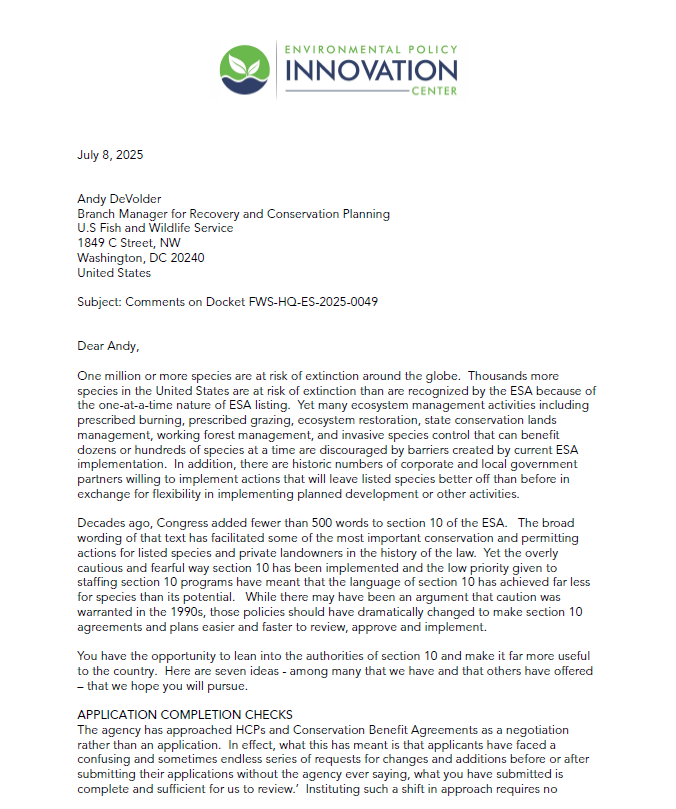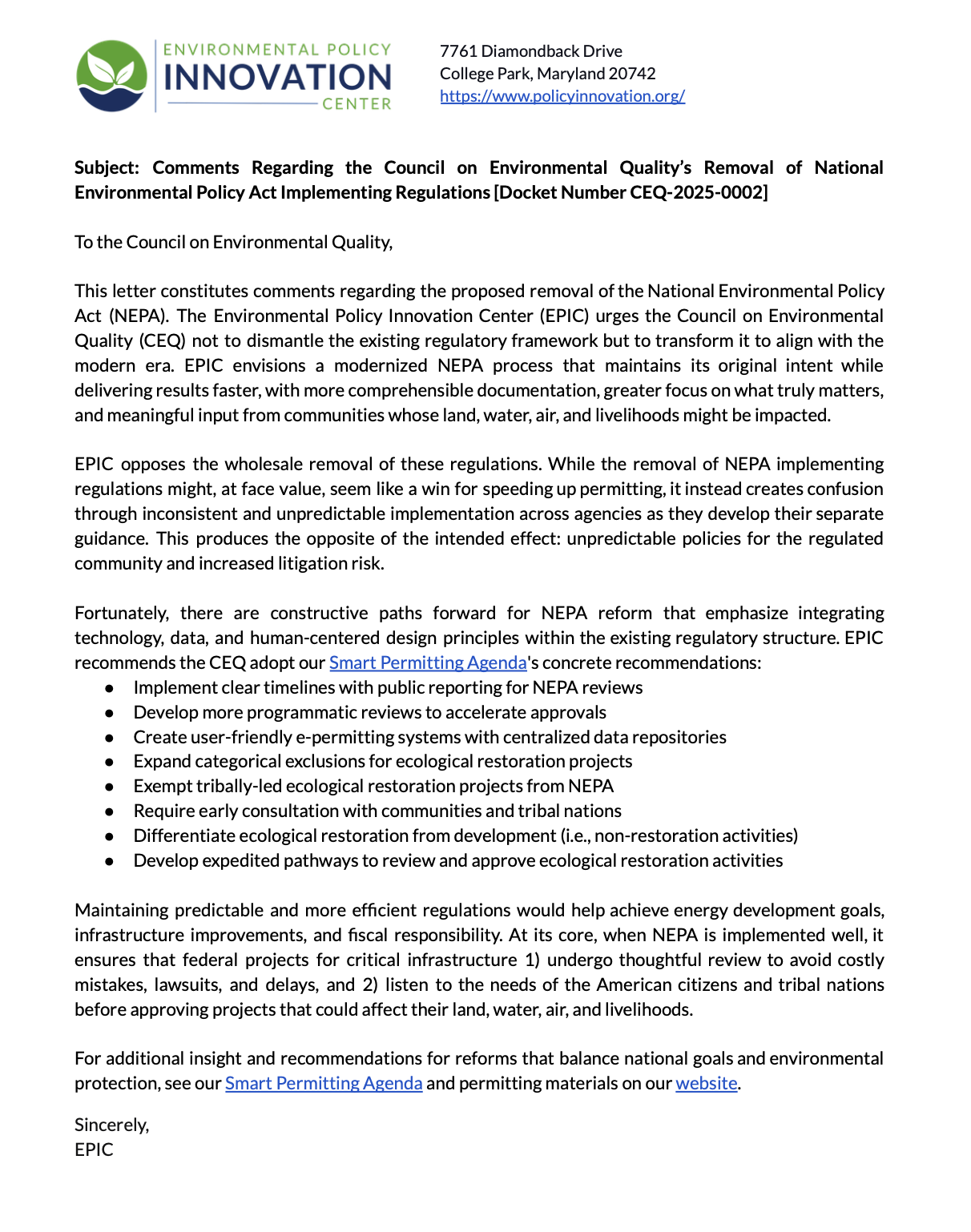Using Procurement & Finance to Accelerate Conservation
What if governments could define and purchase environmental outcomes from ecological restoration projects just like they budget for and purchase computers and desks? We work on federal- and state-level contracting reform that makes it easier for government to define what outcomes they want to purchase and pave the way for efficient delivery of those outcomes. Contracting reform and the development of responsible environmental credit markets can help attract private sector investment in public climate, water, and environmental goals.
Our Initiatives
-
![]()
Buy Environmental Outcomes
Pay for Success is an exciting new way to pay for measurable environmental outcomes. Jurisdictions and stakeholders can buy environmental services just like buying goods. This has the potential to generate faster and cheaper delivery of environmental services such as clean water and stream restoration than status quo approaches. Faced with clunky and outdated environmental legislation that favors process over innovation, we work to uncover the best Pay for Success stories and iterate on the model to make it work for conservation in more places with better outcomes.
-
![]()
Enable Conservation Finance
While private conservation finance has played a secondary role over the last 20 years in delivering more than $4.2 billion in capital compared to tens of billions in public spending, private finance has significant room to grow over the next decade. It’s also not just a funding source. Approaches through which private capital are deployed can dramatically improve the cost-effectiveness of public funding, can support innovation to a greater degree than public funds, and facilitate greater lending capacity so that restoration happens much faster. Each of these secondary strengths of private capital increase the long-term benefits of conservation action. Over the next 20 years, private, profit-seeking capital is likely to continue to revolutionize the speed and types of conservation progress we can achieve.
-
![]()
Expand Environmental Markets
Environmental markets make it possible to reduce and compensate for impacts to water quality, biodiversity and threatened species. Nutrient trading mitigates water quality impacts through buying credits from entities that are actively restoring waterways and reducing nutrient impacts. Major environmental policies such as the Clean Water Act and Endangered Species Act already drive much of our nation’s environmental markets, and drive us toward Net Zero Mitigation.
-
![]()
Accelerate Government Conservation Investment
The benefits of federal land acquisition and conservation for the public good are increasingly obvious - air and water quality, climate change mitigation, wildlife habitat, and human health and recreation to name a few - just as development pressures on America’s lands grow.
What’s New
Comments on “Endangered Species Act (ESA) Section 10(a) Program Implementation; Development of Conservation Benefit Agreements and Habitat Conservation Plans, and Issuance of Associated Enhancement of Survival and Incidental Take Permits” (FWS-HQ-ES-2025-0049-0001)
Discover how small environmental restoration firms can scale their impact and earn revenue through outcomes-based funding like Pay for Success (PFS) contracts. In our latest feature, we talk with Maycomb Capital—a women-owned impact investing firm—about how they use flexible, mission-aligned financing to support projects that deliver measurable results for underserved communities. Learn what funders look for and how to secure the capital you need to launch your next high-impact initiative.
Comments on “2022 North American Industry Classification System (NAICS) - Revisions for 2027” (Docket ID USBC-2024-0032)
Last month, EPIC submitted detailed public comments opposing a proposed federal rule that would weaken the Endangered Species Act by removing habitat destruction from the definition of "harm." If the Rule goes through, it has profound implications for the restoration economy and Tribal communities.
Comment: Opposition to the Proposed Rule to Rescind the Definition of "Harm" Under the Endangered Species Act
This blog is a first look at the Council on Environmental Quality’s (CEQ) Permitting Technology Action Plan, which aims to modernize federal permitting processes. The plan includes data standards for interoperability between agencies, service delivery standards for workflow automation and digital documents, and a maturity model for agencies to gauge their progress. Key highlights include implementing data standards, improving document management, and using GitHub for open collaboration. We note the potential for multi-agency procurement and prize competitions and outline potential impacts for agencies, applicants, and vendors. We express cautious optimism due to the plan's technical depth, interoperability focus, and use of existing work but also note concerns about talent gaps and the aggressive initial 90-day implementation timeline.
Biodiversity credit markets are new and unfamiliar to most of us, and misconceptions abound. Because carbon credit markets have attracted so much attention - good, bad, and ugly, there is a (mostly) false impression that carbon markets are, or should be the single model for a biodiversity market, and that couldn’t be farther from the truth. I spoke recently as part of an excellent series on biodiversity credits hosted by the Environmental Leadership Training Initiative, and below I’ve adapted my comments from that event to address some of the myths and doubts often posed by both advocates and skeptics. If others come to mind, go ahead and throw them in the comments below.
EPIC champions a bold approach to environmental restoration, aligning with the Abundance mindset by streamlining wetland restoration, leveraging technology, and using pay-for-success models. By focusing on outcomes over process, EPIC aims to make nature restoration faster, scalable, and impactful—ensuring clean air, water, and ecosystems are abundant and accessible.
The goal of this project was to determine which financial investments from foundations and other impact investors would be most likely to drive others to invest in NBS. We interviewed fourteen companies and investors focused on deploying capital into nature-based investments.
EPIC submitted public comments opposing the wholesale removal of NEPA regulations by the Council on Environmental Quality (CEQ), arguing it would create confusion and increase litigation risk. Instead, we proposed modernizing the NEPA process through our Smart Permitting Agenda, which includes implementing clear timelines, developing programmatic reviews, creating user-friendly e-permitting systems, and establishing expedited pathways for ecological restoration. We believe an updated regulatory framework can maintain NEPA's original intent while delivering faster results and ensuring meaningful community input.
Our Principles
-
Simplifying Contracting.
Rather than treating environmental projects like service delivery, they should be considered commodities that buyers of environmental outcomes can order and pay for when they are delivered.
-
Define Environmental Outcomes.
Most major conservation laws were written at a time when data on conservation outcomes were hard to come by, difficult for the public to find, and difficult to understand. But now we live in a world full of data and analytical tools. Government RFPs can define and quantify environmental outcomes such as feet of restored stream, acres of habitat, and nutrient pollution reductions, opening the door to creative delivery of measurable outcomes by the private sector.
-
Shift Risk to the Private Sector.
Government should identify and quantify its desirable environmental outcomes and then get out of the way. The restoration economy has been growing steadily and today the private sector can deliver large-scale restoration projects where payments are made upon delivery of outcomes.

































